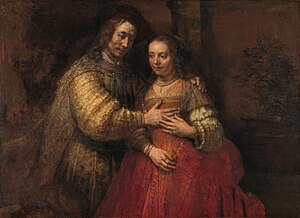The Jew's Bride

|
| The Jew's Bride |
|---|
| Rembrandt van Rijn , 1667 |
| Oil on canvas |
| 121.5 x 166.5 cm |
| Rijksmuseum Amsterdam |
The Jew's Bride (oil on canvas, 121.5 × 166.5 cm, Dutch : Het Joodse bruidje ) is a painting by Rembrandt van Rijn that was completed in 1667. The painting is a permanent exhibit in the Rijksmuseum Amsterdam .
Image description
A dark, vague room is depicted in which an elegantly dressed man and a woman are. The man has put his arm around the woman and is holding his hand to her chest. She touches his hand with her fingertips. Both look into the void. In the background, next to the woman, you can see a plant in a pot. Behind her is an architectural fragment. The two people are painted the brightest. Their clothes and bodies are detailed and accurately depicted. The more the gaze moves away from the center of the picture, the softer, more imprecise and flowing the brushwork becomes.
The color choice consists mainly of brown and gold tones, as well as the intense red in the woman's dress.
Background and interpretation
The painting got its current name in the early 19th century when an Amsterdam art collector viewed the depiction as a scene of a Jewish father giving his daughter a necklace on her wedding day. However, this interpretation no longer agrees with the doctrine, the identity of the couple is uncertain. This uncertainty is exacerbated by the lack of oral tradition, so that only the universal theme of a couple remains.
Speculations regarding the identity of the portrayed range from Rembrandt's son Titus and his bride, to the Amsterdam poet Miguel de Barrios and his wife, to various Old Testament couples such as Abraham and Sara or Boaz and Ruth . Most likely, however, it is the representation of Isaac and Rebekah as described in Genesis 26.8 EU . This is supported by a drawing by Rembrandt on the same subject.
Web links
- Het Joodse Bruidje, Rembrandt van Rijn, ca.1665 - ca.1669 on the website of the Rijksmuseum Amsterdam (Dutch and German)